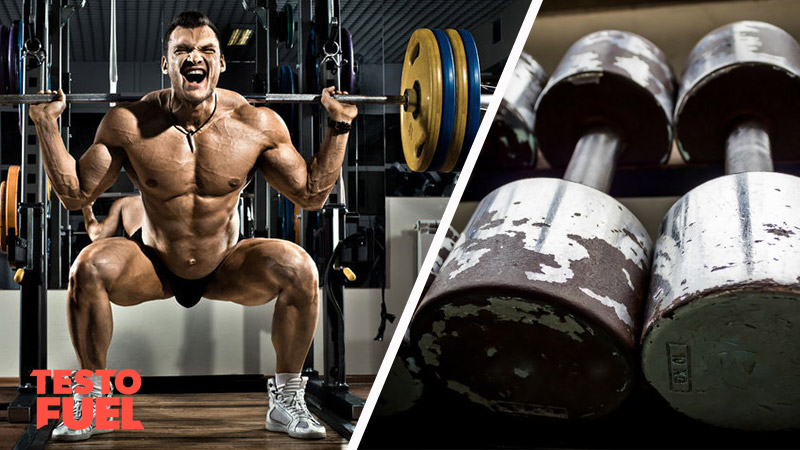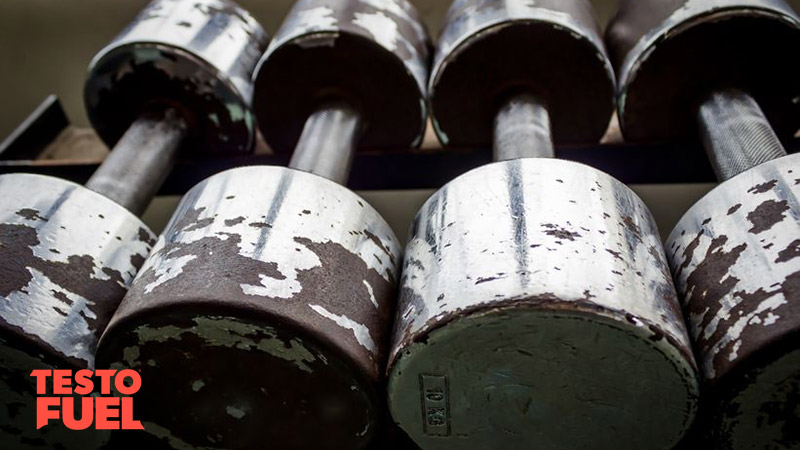TestoFuel Blog : Make Gains & Pack on the Muscle

Testosterone in a powerful hormone – it presents us with male characteristics, improves health, boosts lean muscle, shreds fat and makes us stronger. This article introduces you to our 5 top weight training tips to boost testosterone.
Weight training robustly stimulates muscle growth and strength, and can also increase your testosterone levels. In fact, it has long been thought that lifting weights is one of the best natural T-boosters out there. The problem is though that if you don’t train correctly you won’t maximize the effects.
So what are the best ways to use weight training to boost testosterone? We have the answers, right here:
Free weight exercises are preferred over machines by strength coaches as they involve greater muscle mass, and higher levels of inter-muscular coordination because of the greater stabilization that is required.
A study done in the Journal of Strength and Conditioning Research [1] found that squats provided a greater T boosting response in comparison to leg presses, suggesting that free weight exercises seem to induce greater hormonal responses to resistance exercise than machine weight exercises using similar lower-body multi-joint movements and primary movers.
It makes sense to aim to complete the bulk of your training program on big, compound exercises if your goal is to increase your T levels.-Aim for the big lifts:
Studies have also found that large muscle-mass/multi-joint exercises should be performed prior to small muscle-mass/single-joint exercises in order to maximize muscle growth and anabolic hormone release [2]

Key Point: Include large muscle, compound exercises in your free weight program to ramp up your T levels and boost muscle mass.
There’s a considerable amount of evidence to suggest that if you’re goal is to increase T then go lower on the reps- but not too low.
#Study 1: Kraemer et al [3].
This research used ‘heavy resistance exercise protocols’ (HREPS) to see how it affected anabolic hormonal response- 16 volunteers were assigned into one of two groups-
Group 1 reported higher serum T levels. Interestingly, group 2 reported higher growth hormone values.
#Study 2: Craig et al [4]
This study observed the response to 12 weeks of weight training in males of different ages. Using a slightly higher rep count of 8-10 reps, T levels significantly increased indicating that strength training can induce a T release. Not only that- there were also increases in growth hormone too!
This is where the research gets interesting- when you look at the effects of slightly lighter loads (more of a traditional bodybuilder approach).
#Study 3: Crewther et al [5]
This study is a fascinating one- a bunch of weight-training males were split into one of three groups:
The study reported that the group with the largest increase in T levels was Group 2- the hypertrophy group– this was attributed to the increase in overall volume.
The idea is to lift heavy enough that your body is put under stress. Make sure you get out of your comfort zone- once you’ve mastered technique in a lift then load it up. Heavy.
Key Point: Train heavy with low reps- aim for no more than 10 reps per set
When you’re using heavy weights its easy to reward yourself with long, drawn out rest periods in between sets – you deserve it right? But this could be hampering your progress.
A study by Kraemer et al [6] found that when load was controlled, higher volume and lower rest periods of 1 minute as opposed to 3 minutes significantly elevated T levels as well as other anabolic hormones.
Likewise, a study by Villanueva et al [7] used 6 healthy young men to determine if the use of relatively short rest interval lengths between sets in a strength-type protocol could augment the acute testosterone response.
The study found that rest times of 60-90 seconds lead to more significant increases in acute anabolic hormone release, concluding that shorter rest intervals within high-intensity strength training may lead to concomitant enhancements in muscle strength and size.
Key point: Rest 60 seconds between sets but up to 5 minutes between exercises if you need to.
With all the will in the world you want to push yourself in the gym- and sometimes this means hitting long sessions.
But evidence suggests that if you want to keep your T levels elevated you to need to keep your sessions short and productive– and now that you’ll be keeping your rest times low [6,7], it should be that little bit easier.
When you start a training session your T levels start to increase- they peak at around 30 minutes and then start to trail off. At that point your cortisol levels increase- this is the hormone that has an opposite effect on your T levels. Whilst its not a waste of time to train with lower T levels it most certainly isn’t as productive.
Whilst we don’t think its necessary to have a session ‘alarm clock’ where you have to be out of the door within 45 minutes, we do feel that sessions need to be productive- and the more time you hang around the gym the longer your sessions will be.
By limiting your rest time and lifting heavy you’ll increase productivity and naturally finish your sessions quicker anyway
Key Point: Keep your gym sessions limited- not so much by time but by productivity.
High Intensity Interval Training, or HIIT is a method of training that involves repeated bouts of high intensity work followed by periods of recovery- its typically done on cardio equipment, but cant be incorporated into body weight or resistance training too.
For example, Paton et al [8] reported a 97% increase in testosterone in a group of road cyclists undergoing 8, 30 minute sessions including single-leg jumps and high-intensity cycling. This was in comparison to a 62% increase in the lower intensity group.
Likewise, a study by Hackney [9] studied the hormone changes in 15 athletes who were assigned to either a HIIT group or a steady state training group- whilst both groups increased T levels, the HIIT group increase was much higher.
Key Point: Aim for 2 HIIT sessions per week- on different days to your weight lifting sessions.
Weight training is the number one way for you to boost your testosterone levels naturally- it stimulates a big anabolic response, and sparks muscle growth. The problem is that there are just many variables to training properly that you might not necessarily boosting testosterone to its full potential- it is important to ensure that you incorporate these tips into your training routine to maximize results.